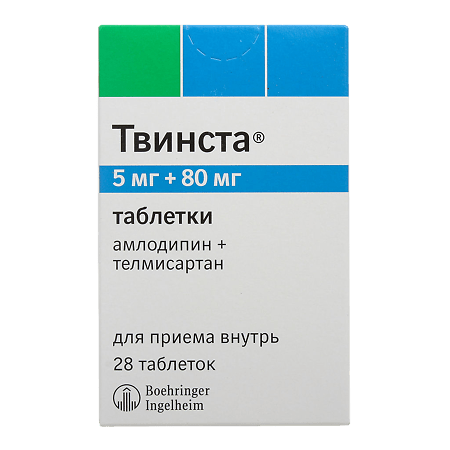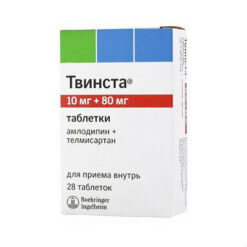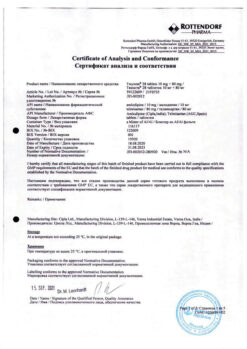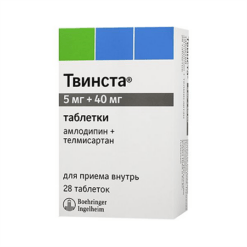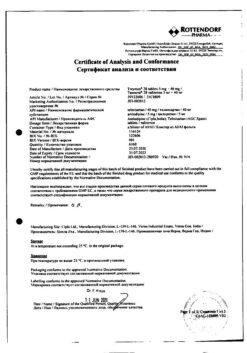No products in the cart.
Twinsta, tablets 5 mg+80 mg 28 pcs
€44.79 €37.32
Description
Twinsta is a combination drug containing two hypotensive agents with complementary actions to control blood pressure in patients with arterial (essential) hypertension: an angiotensin II receptor antagonist, telmisartan, and a “slow” calcium channel blocker, a dihydropyridine derivative, amlodipine. The combination of these substances has an additive hypotensive effect, lowering blood pressure to a greater extent than each individual component. The drug, taken once a day, results in an effective and sustained reduction of blood pressure within 24 hours.
Telmisartan is a specific angiotensin II receptor antagonist (type AT1) that is effective when taken orally. It has high affinity for the AT1 subtype of angiotensin II receptors, through which the action of angiotensin II is realized. It displaces angiotensin II from binding to the receptor, having no agonist effect against this receptor. Telmisartan binds only to the AT1 subtype of the angiotensin II receptor. The binding is long-lasting. It has no affinity for other receptors, including the AT2 receptor. Reduces blood aldosterone concentration, does not inhibit plasma renin and does not block ion channels. Telmisartan does not inhibit angiotensin-converting enzyme (kinininase I) (an enzyme that also degrades bradykinin). Therefore, an increase in bradykinin-induced side effects is not expected. In patients, telmisartan at a dose of 80 mg completely blocks the hypertensive effects of angiotensin II.
The onset of hypotensive action is noted within 3 hours after the first dose of telmisartan. The action of the drug persists for 24 hours and remains significant up to 48 hours. A pronounced hypotensive effect usually develops 4 to 8 weeks after regular use. In patients with arterial hypertension, telmisartan reduces systolic and diastolic blood pressure (BP) without affecting heart rate (HR). In case of abrupt telmisartan withdrawal BP gradually returns to baseline levels without development of “withdrawal” syndrome.
Amlodipine is a dihydropyridine derivative and belongs to the class of “slow” calcium channel blockers. It inhibits transmembrane entry of calcium ions into cardiomyocytes and vascular smooth muscle cells. The mechanism of antihypertensive action of amlodipine is associated with a direct relaxant effect on vascular smooth muscle cells, which leads to a decrease in peripheral vascular resistance and BP. In patients with arterial hypertension, administration of amlodipine once daily provides clinically significant BP reduction for 24 hours. Orthostatic arterial hypotension is not typical during the use of amlodipine due to the slow onset of action of the drug.
In patients with arterial hypertension and normal renal function, amlodipine at therapeutic doses resulted in decreased renal vascular resistance, increased glomerular filtration rate and effective renal plasma blood flow, without changes in filtration or proteinuria. Amlodipine does not lead to any metabolic adverse effects or changes in plasma lipid content and is therefore suitable for use in patients with bronchial asthma, diabetes mellitus and gout. The use of amlodipine in patients with heart failure is not accompanied by negative inotropic effect (does not reduce exercise tolerance and left ventricular ejection fraction). Pharmacokinetics. Pharmacokinetics of fixed-dose combination. The rate and degree of drug absorption are equivalent to the bioavailability of telmisartan and amlodipine when used as separate tablets.
Pharmacokinetics
Pharmacokinetics of fixed-dose combination
The rate and degree of absorption of Twinsta is equivalent to the bioavailability of telmisartan and amlodipine when used as separate tablets.
Pharmacokinetics of individual components
Telmisartan
Intake
It is rapidly absorbed from the gastrointestinal tract when taken orally. Bioavailability is 50%. When taken concomitantly with food, AUC reduction ranges from 6% (at a dose of 40 mg) to 19% (at a dose of 160 mg). In 3 hours after oral administration, plasma concentrations level off, regardless of food intake.
Distribution
Binding to plasma proteins is 99.5%, mainly to albumin and alpha-1 glycoprotein. Average apparent Vd at an equilibrium concentration of 500L.
Metabolism
Telmisartan is metabolized by conjugation with glucuronic acid. Metabolites are pharmacologically inactive.
Excretion
T1/2 – more than 20 h. Cmax in plasma and, to a lesser extent, AUC increase disproportionately to dose. There are no data on clinically significant accumulation of telmisartan. It is excreted unchanged in the intestine, renal excretion is less than 2%. Total plasma clearance is high (900 ml/min) compared to hepatic blood flow (about 1500 ml/min).
Amlodipine
Intake
After oral administration of amlodipine at therapeutic doses, Cmax in plasma is reached after 6-12 hours. Absolute bioavailability ranges from 64% to 80%. Food intake does not affect bioavailability of amlodipine.
Distribution
Vd amlodipine is approximately 21 l/kg. In in vitro studies, approximately 97.5% of circulating amlodipine has been shown to bind to plasma proteins in patients with arterial hypertension.
Metabolism
Amlodipine is largely (approximately 90%) metabolized in the liver to form inactive metabolites.
Elevation
Elevation of amlodipine from blood plasma is biphasic. T1/2 is approximately 30-50 h. Stable plasma levels are reached after continuous drug administration for 7-8 days. Amlodipine is excreted by the kidneys both as unchanged (10%) and as metabolites (60%).
Pharmacokinetics in special clinical cases:
There is a difference in plasma concentrations in males and females. Cmax and AUC were approximately 3 and 2 times higher in women compared to men, respectively, with no significant effect on efficacy.
The pharmacokinetics of telmisartan in elderly patients do not differ from younger patients. No dose adjustment is required. Amlodipine clearance tends to decrease in elderly patients, resulting in increased AUC and T1/2.
Telmisartan dose changes are not required in patients with renal impairment, including patients on hemodialysis. Telmisartan is not eliminated by hemodialysis.
The pharmacokinetics of amlodipine are not significantly altered in patients with impaired renal function.
Pharmacokinetics studies conducted in patients with hepatic impairment have shown that the absolute bioavailability of telmisartan increases to almost 100%.T1/2 in patients with hepatic impairment does not change. In patients with hepatic impairment, the clearance of amlodipine was decreased, resulting in an increase in AUC of approximately 40-60%.
Indications
Indications
arterial hypertension (for patients whose blood pressure is not sufficiently controlled with telmisartan or amlodipine in monotherapy);
arterial hypertension (for patients for whom combination therapy is indicated);
patients with arterial hypertension receiving telmisartan and amlodipine in the form of separate tablets, as a replacement for this therapy.
Pharmacological effect
Pharmacological effect
Twynsta is a combination drug containing two antihypertensive substances with complementary effects that help control blood pressure in patients with arterial (essential) hypertension: an angiotensin II receptor antagonist, telmisartan, and a blocker of “slow” calcium channels, a dihydropyridine derivative, amlodipine. The combination of these substances has an additive hypotensive effect, reducing blood pressure to a greater extent than each individual component. The drug, taken once a day, leads to an effective and sustained reduction in blood pressure over 24 hours.
Telmisartan is a specific angiotensin II receptor antagonist (AT1 type), effective when taken orally. It has a high affinity for the AT1 subtype of angiotensin II receptors, through which the action of angiotensin II is realized. Displaces angiotensin II from its connection with the receptor, without having an agonist effect on this receptor. Telmisartan binds only to the AT1 subtype of angiotensin II receptors. The connection is long-term. It has no affinity for other receptors, including the AT2 receptor. Reduces the concentration of aldosterone in the blood, does not inhibit renin in the blood plasma and does not block ion channels. Telmisartan does not inhibit angiotensin-converting enzyme (kininase I) (an enzyme that also breaks down bradykinin). Therefore, an increase in the side effects caused by bradykinin is not expected. In patients, telmisartan at a dose of 80 mg completely blocks the hypertensive effect of angiotensin II.
The onset of the hypotensive effect is observed within 3 hours after the first dose of telmisartan. The effect of the drug lasts for 24 hours and remains significant for up to 48 hours. A pronounced hypotensive effect usually develops 4-8 weeks after regular use. In patients with arterial hypertension, telmisartan reduces systolic and diastolic blood pressure (BP) without affecting heart rate (HR). In case of abrupt withdrawal of telmisartan, blood pressure gradually returns to the initial level without the development of withdrawal syndrome.
Amlodipine is a dihydropyridine derivative and belongs to the class of “slow” calcium channel blockers. It inhibits the transmembrane entry of calcium ions into cardiomyocytes and vascular smooth muscle cells. The mechanism of the antihypertensive effect of amlodipine is associated with a direct relaxing effect on vascular smooth muscle cells, which leads to a decrease in peripheral vascular resistance and a decrease in blood pressure. In patients with arterial hypertension, the use of amlodipine once a day provides a clinically significant reduction in blood pressure over 24 hours. Orthostatic hypotension is not common during the use of amlodipine due to the slow onset of action of the drug.
In patients with arterial hypertension and normal renal function, amlodipine at therapeutic doses resulted in a decrease in renal vascular resistance, an increase in glomerular filtration rate and effective plasma blood flow in the kidneys, without changing filtration or proteinuria. Amlodipine does not cause any metabolic adverse effects or changes in plasma lipids and is therefore suitable for use in patients with asthma, diabetes mellitus and gout. The use of amlodipine in patients with heart failure is not accompanied by a negative inotropic effect (exercise tolerance is not reduced, and the left ventricular ejection fraction is not reduced). Pharmacokinetics. Pharmacokinetics of fixed dose combinations. The rate and extent of absorption of the drug are equivalent to the bioavailability of telmisartan and amlodipine when used in the form of separate tablets.
Pharmacokinetics
Pharmacokinetics of fixed dose combinations
The rate and extent of absorption of Twynsta are equivalent to the bioavailability of telmisartan and amlodipine when administered as separate tablets.
Pharmacokinetics of individual components
Telmisartan
Suction
When taken orally, it is quickly absorbed from the gastrointestinal tract. Bioavailability – 50%. When taken simultaneously with food, the reduction in AUC ranges from 6% (at a dose of 40 mg) to 19% (at a dose of 160 mg). 3 hours after oral administration, the concentration in the blood plasma levels off, regardless of food intake.
Distribution
Plasma protein binding is 99.5%, mainly with albumin and alpha-1 glycoprotein. The average apparent Vd at equilibrium concentration is 500 l.
Metabolism
Telmisartan is metabolized by conjugation with glucuronic acid. Metabolites are pharmacologically inactive.
Removal
T1/2 – more than 20 hours. Cmax in blood plasma and, to a lesser extent, AUC increase disproportionately to the dose. There are no data on clinically significant accumulation of telmisartan. Excreted through the intestines unchanged, excretion by the kidneys is less than 2%. The total plasma clearance is high (900 ml/min) compared to the hepatic blood flow (about 1500 ml/min).
Amlodipine
Suction
After taking amlodipine orally in therapeutic doses, Cmax in blood plasma is achieved within 6-12 hours. The absolute bioavailability ranges from 64% to 80%. Food intake does not affect the bioavailability of amlodipine.
Distribution
Vd of amlodipine is approximately 21 l/kg. In vitro studies have shown that in patients with arterial hypertension, approximately 97.5% of circulating amlodipine is bound to plasma proteins.
Metabolism
Amlodipine is largely (approximately 90%) metabolized in the liver to form inactive metabolites.
Removal
The elimination of amlodipine from blood plasma occurs in two phases. T1/2 is approximately 30-50 hours. Steady-state plasma levels are achieved after continuous administration of the drug for 7-8 days. Amlodipine is excreted by the kidneys both unchanged (10%) and in the form of metabolites (60%).
Pharmacokinetics in special clinical situations:
There is a difference in plasma concentrations between men and women. Cmax and AUC were approximately 3-fold and 2-fold, respectively, higher in women compared to men, with no significant effect on efficacy.
The pharmacokinetics of telmisartan in elderly patients does not differ from young patients. No dose adjustment is required. In elderly patients, there is a tendency to decrease the clearance of amlodipine, which leads to an increase in AUC and T1/2.
No dose adjustment of telmisartan is required in patients with renal failure, including patients on hemodialysis. Telmisartan is not removed by hemodialysis.
The pharmacokinetics of amlodipine in patients with impaired renal function does not change significantly.
Pharmacokinetic studies conducted in patients with impaired liver function showed that the absolute bioavailability of telmisartan increases to almost 100%. T1/2 in patients with impaired liver function does not change. In patients with hepatic impairment, the clearance of amlodipine was reduced, resulting in an increase in AUC by approximately 40-60%.
Special instructions
Special instructions
The drug should be prescribed with caution if the patient has the following conditions:
liver dysfunction;
bilateral renal artery stenosis or stenosis of the artery of a single kidney, severe renal dysfunction. In some patients, due to suppression of the RAAS, especially when using a combination of drugs acting on this system, renal function is impaired (including acute renal failure). Therefore, therapy accompanied by such a double blockade of the RAAS should be carried out strictly individually and with careful monitoring of renal function (including periodic monitoring of potassium and creatinine levels in the blood serum). In cases where vascular tone and renal function depend primarily on the activity of the RAAS (for example, in patients with chronic heart failure or kidney disease, including renal artery stenosis, or stenosis of the artery of a single kidney), the prescription of drugs that affect this system may be accompanied by the development of acute arterial hypotension, hyperazotemia, oliguria, and, in rare cases, acute renal failure;
condition after kidney transplantation (no experience of use);
decreased blood volume and/or hyponatremia due to previous diuretic therapy, restriction of salt intake, diarrhea or vomiting;
double blockade of the RAAS;
other conditions characterized by activation of the RAAS;
primary aldosteronism;
stenosis of the aortic and mitral valve, idiopathic hypertrophic subaortic stenosis;
heart failure;
hyperkalemia;
hereditary fructose intolerance;
in patients with diabetes mellitus and additional cardiovascular risk, i.e. In patients with diabetes mellitus and concomitant coronary artery disease (CAD), the risk of fatal myocardial infarction and sudden cardiovascular death may be increased when treated with antihypertensive agents such as angiotensin II receptor antagonists and ACE inhibitors. In patients with diabetes mellitus, IHD may be asymptomatic and therefore not be diagnosed. Patients with diabetes mellitus should undergo appropriate testing, such as exercise testing, to diagnose and treat coronary artery disease, respectively, before starting treatment with Twynsta.
Other instructions
Twynsta is less effective in treating patients of the Negroid race (in this population, renin activity in the blood is usually reduced).
There is no data on the use of Twynsta in patients with unstable angina, acute myocardial infarction and within one month after the onset of myocardial infarction.
Impact on the ability to drive vehicles and operate machinery
Studies of the effect on the ability to drive vehicles and operate machinery have not been conducted. However, it should be taken into account that during treatment, undesirable effects such as fainting, drowsiness or dizziness may occur. Therefore, you should be careful when driving vehicles or machinery. If patients experience these sensations, they should avoid performing potentially dangerous activities such as driving or operating machinery.
Active ingredient
Active ingredient
Amlodipine, Telmisartan
Composition
Composition
1 tablet contains:
active ingredients:
amlodipine besilate 6.935 mg, which corresponds to the content of amlodipine 5 mg, telmisartan 40 and 80 mg;
excipients:
sodium hydroxide,
povidone K25,
meglumine,
sorbitol,
magnesium stearate,
microcrystalline cellulose,
pregelatized starch,
corn starch,
colloidal silicon dioxide,
mixture of dyes*.
composition of the dye mixture: iron oxide black (E172) – 76%, iron oxide yellow (E172) – 4%, FD&C blue No. 1 (brilliant blue FCF aluminum varnish), aluminum pigment (E133) – 20%
Pregnancy
Pregnancy
No special studies of Twynsta have been conducted during pregnancy and lactation. The effects associated with the individual components of the drug are described below.
Pregnancy
Telmisartan
The use of angiotensin II receptor antagonists (ARA II) is contraindicated during pregnancy. If pregnancy is diagnosed, the drug should be stopped immediately. If necessary, alternative therapy should be prescribed.
It is known that the use of ARA II during the II and III trimesters of pregnancy has a fetotoxic effect (decreased renal function, oligohydramnios, delayed ossification of the fetal skull), and neonatal toxicity (renal failure, arterial hypotension and hyperkalemia) is also observed.
Amlodipine
The limited data available regarding the effects of amlodipine or other calcium receptor antagonists do not indicate adverse effects on the fetus. However, there may be a risk of slowing down the birth process.
Breastfeeding period
No special studies have been conducted on the excretion of telmisartan and/or amlodipine in breast milk in women. Animal studies have shown that telmisartan is excreted in the milk of lactating animals. Given the potential for adverse reactions, the decision to continue breastfeeding or discontinue therapy should be made taking into account its significance for the mother. No studies have been conducted on the effect on human fertility.
Contraindications
Contraindications
obstructive diseases of the biliary tract;
severe arterial hypotension;
obstruction of the left ventricular outflow tract (including high degree of aortic stenosis);
hemodynamically unstable heart failure after acute myocardial infarction;
severe liver failure;
shock;
fructose intolerance and glucose/galactose malabsorption syndrome or sucrase/isomaltase deficiency;
pregnancy;
breastfeeding period;
age under 18 years (efficacy and safety have not been established);
hypersensitivity to active ingredients or excipients;
hypersensitivity to other dihydropyridine derivatives.
Twynsta should be prescribed with caution to patients with:
obstructive diseases of the biliary tract or liver failure;
bilateral renal artery stenosis or stenosis of the artery of a single kidney;
condition after kidney transplantation;
decreased blood volume and/or hyponatremia;
double blockade of the renin-angiotensin-aldosterone system (RAAS);
other conditions characterized by activation of the RAAS;
primary aldosteronism;
aortic and mitral valve stenosis, obstructive hypertrophic cardiomyopathy;
heart failure;
hyperkalemia;
diabetes mellitus with additional cardiovascular risk (i.e. concomitant coronary artery disease /CHD);
after 1 month after acute myocardial infarction and unstable angina.
Side Effects
Side Effects
expected based on experience with telmisartan
expected based on experience with amlodipine
expected with the simultaneous use of telmisartan and amlodipine
Within systemic organ classes, the following categories are used according to the frequency of side effects: very often (≥1/10); often (≥1/100, <1/10); uncommon (≥1/1000, <1/100); rare (≥1/10,000, <1/1000); very rare (frequency unknown (cannot be calculated from available data).
System-organ class
Side effect
Frequency of occurrence
Infections and infestations
Cystitis3)
Rarely
Urinary tract infections1)
Uncommon
Upper respiratory tract infections1)
Uncommon
Sepsis, incl. with fatal outcome1)
Rarely
Psychotic disorders
Depression3), anxiety3), insomnia3)
Rarely
Mood lability2), confusion2)
Frequency unknown
Nervous system disorders
Dizziness3)
Often
Drowsiness3), migraine3), headache3), paresthesia3)
Uncommon
Decreased sensitivity or resistance to external factors3), impaired taste3), fainting3), tremor3), peripheral neuropathy3)
Rarely
Immune system disorders
Anaphylactic reaction1)
Rarely
Increased sensitivity1),2)
Rarely1),
Frequency unknown1)
Visual disorders
Visual impairment3)
Rarely
Hearing disorders
Vertigo3)
Uncommon
Tinnitus2)
Frequency unknown
Violations by
cardiovascular
systems
Bradycardia3), palpitations3)
Uncommon
Tachycardia1)
Uncommon
Myocardial infarction2)
Rarely
Arrhythmia2), ventricular tachycardia2), atrial fibrillation2)
Frequency unknown
Marked decrease in blood pressure3), orthostatic hypotension3)
Uncommon
Respiratory system disorders
Cough3)
Uncommon
Shortness of breath1),2)
Uncommon1)
Frequency unknown2)
Rhinitis2)
Frequency unknown
Violations by
gastrointestinal
tract
Abdominal pain3), diarrhea3), nausea3), flatulence1)
Uncommon
Vomiting3), dyspepsia3), discomfort in the stomach1)
Rarely
Changes in the rhythm of bowel movements2), pancreatitis2), gastritis2)
Frequency unknown
Liver dysfunction1)
Rarely
Hepatitis2), jaundice2)
Frequency unknown
Increased activity of liver transaminases (mainly reflecting cholestasis)2)
Frequency unknown
Increased liver enzyme levels3)
Rarely
Skin and subcutaneous tissue disorders
Eczema3), erythema3), rash1),3), drug rash1), toxic rash1)
Rarely
Itchy skin3)
Uncommon
Angioedema1),2)
Rare1), frequency unknown2)
Hyperhidrosis1),2)
Uncommon1), frequency unknown2)
Urticaria1),2)
Rare1), frequency unknown2)
Alopecia2), purpura2), skin discoloration2), erythema multiforme2), exfoliative dermatitis2), Stevens-Johnson syndrome2), photosensitivity reaction2), vasculitis2)
Frequency unknown
Musculoskeletal disorders
Arthralgia3), back pain3), muscle spasms (calf muscle cramps)3), myalgia3)
Uncommon
Pain in the lower extremities3), pain in the tendons (symptoms resembling tendinitis)1)
Rarely
Disorders of the genitourinary system
Nocturia3)
Rarely
Renal dysfunction, including acute renal failure1), urinary disorders2), frequent urination2)
Frequency unknown
Erectile dysfunction3)
Uncommon
General violations
Peripheral edema3)
Often
Asthenia (weakness)3), chest pain3), increased fatigue3), swelling3)
Uncommon
Malaise3), flu-like syndrome1), feeling of a rush of blood to the face3), gum hypertrophy3), dryness of the oral mucosa3)
Rarely
Pain2), weight gain2), weight loss2), gynecomastia2)
Frequency unknown
Reactions identified during
special
research
Increased concentration of uric acid in the blood3), increase in the level of creatinine in the blood1) and creatine phosphokinase (CPK)1),
decrease in hemoglobin1) (anemia, weakness), hypoglycemia (in patients with diabetes mellitus)1), eosinophilia1)
Rarely
Leukopenia2), hyperglycemia2)
Frequency unknown
Hyperkalemia1)
Uncommon
Thrombocytopenia1),2)
Rarely1), frequency unknown2)
Additional information regarding individual components
Side effects previously reported with one of the components of the drug (amlodipine or telmisartan) may be increased with Twynsta, even if they were not observed in clinical studies or during the post-marketing period.
Additional information regarding the combination of components
Peripheral edema, a dose-related side effect of amlodipine, was observed less frequently in patients receiving the combination of telmisartan and amlodipine than in patients receiving amlodipine alone.
Interaction
Interaction
Interactions between the two active components included in fixed doses in this drug were not observed in clinical studies.
There have been no specific studies of drug interactions between Twynsta and other drugs.
Combination of active ingredients
When using Twynsta concomitantly with the following drugs, the following information should be taken into account:
Other antihypertensive drugs
When used simultaneously with other antihypertensive drugs, the hypotensive effect of Twynsta may be enhanced.
Drugs that can lower blood pressure
It can be expected that some drugs, for example, baclofen and amifostine, due to their pharmacological properties, will enhance the hypotensive effect of all antihypertensive drugs, including Twynsta. In addition, orthostatic hypotension may be exacerbated by ethanol, barbiturates, narcotics, or antidepressants.
Corticosteroids (systemic use)
The hypotensive effect may be reduced.
Telmisartan
With simultaneous use of telmisartan with:
other antihypertensive drugs: the hypotensive effect may be enhanced. In one study, with the combined use of telmisartan and ramipril, an increase in AUC0-24 and Cmax of ramipril and ramiprilat was observed by 2.5 times. The clinical significance of this interaction has not been established.
digoxin, warfarin, hydrochlorothiazide, glibenclamide, simvastatin and amlodipine: no clinically significant interaction was detected. There was an increase in the average concentration of digoxin in the blood plasma by an average of 20% (in one case by 39%). When telmisartan and digoxin are prescribed simultaneously, it is advisable to periodically determine the concentration of digoxin in the blood.
lithium preparations: a reversible increase in the concentration of lithium in the blood was observed, accompanied by toxic effects when taking ACE inhibitors. In rare cases, such changes have been reported with the administration of angiotensin II receptor antagonists, in particular telmisartan. When prescribing lithium drugs and angiotensin II receptor antagonists simultaneously, it is recommended to determine the lithium content in the blood.
NSAIDs, including acetylsalicylic acid in doses used as an anti-inflammatory agent, cyclooxygenase-2 (COX-2) inhibitors and non-selective NSAIDs, can cause the development of acute renal failure in patients with reduced blood volume. Drugs that affect the activity of the renin-angiotensin system, incl. telmisartan may have a synergistic effect. In patients receiving NSAIDs and telmisartan, blood volume should be compensated and renal function monitored at the beginning of treatment.
When NSAIDs are used concomitantly with antihypertensive drugs like telmisartan, a decrease in the hypotensive effect via inhibition of the vasodilatory effect of prostaglandins has been reported.
Amlodipine
When using amlodipine simultaneously with:
grapefruit and grapefruit juice: simultaneous use of the drug with grapefruit or grapefruit juice is not recommended, because in some patients, as a result of increased bioavailability of amlodipine, its antihypertensive effects may be enhanced.
inhibitors of the isoenzyme CYP3A4: in a study in elderly patients, diltiazem was shown to inhibit the metabolism of amlodipine, possibly affecting CYP3A4 (plasma concentrations of amlodipine increase by approximately 50% and the effect of amlodipine is enhanced). It cannot be excluded that more active CYP3A4 inhibitors (such as ketoconazole, itraconazole, ritonavir) may increase plasma concentrations of amlodipine to a greater extent than diltiazem.
inducers of the CYP3A4 isoenzyme – anticonvulsants (for example, carbamazepine, phenobarbital, phenytoin, fosphenytoin, primidone), rifampicin, St. John’s wort (Hypericum perforatum): combined use may lead to a decrease in amlodipine plasma concentrations. Regular medical supervision is indicated. During the use of CYP3A4 inducers, as well as after their withdrawal, it is recommended (if possible) to change the dose of amlodipine.
Co-administration of simvastatin at a dose of 80 mg with amlodipine, regardless of dose, increases the exposure of simvastatin to 77% compared with simvastatin monotherapy. Therefore, the dose of simvastatin should not exceed 40 mg/day.
When using the following drugs simultaneously, the following information should be taken into account
The safety of combined use of amlodipine with thiazide diuretics, beta-blockers, ACE inhibitors, long-acting nitrates, nitroglycerin (used sublingually), NSAIDs, antibiotics and oral hypoglycemic agents has been established.
With the simultaneous use of amlodipine and sildenafil, it was shown that each drug had an independent hypotensive effect.
Additional information
The simultaneous use of 240 ml of grapefruit juice with a single dose of amlodipine 10 mg taken orally in 20 healthy volunteers did not lead to a significant effect on the pharmacokinetic properties of amlodipine.
The simultaneous use of amlodipine with cimetidine did not have a significant effect on the pharmacokinetics of amlodipine.
Concomitant use of amlodipine with atorvastatin, digoxin, warfarin or cyclosporine did not significantly affect the pharmacokinetics or pharmacodynamics of these drugs.
Based on experience with other drugs that affect the RAAS, the simultaneous use of Twynsta and potassium-sparing diuretics, potassium supplements, potassium-containing table salt, and other drugs that increase potassium levels in the blood (for example, heparin) may lead to hyperkalemia, so this indicator should be monitored in patients. In this regard, their simultaneous use with telmisartan requires caution.
Overdose
Overdose
Symptoms
No cases of overdose have been identified. Possible symptoms of overdose consist of symptoms from individual components of the drug.
Telmisartan – marked decrease in blood pressure, tachycardia, possibly bradycardia, dizziness, increased serum creatinine concentration, acute renal failure.
Amlodipine – excessive peripheral vasodilation and possibly reflex tachycardia. Severe and possibly prolonged systemic hypotension may occur, even leading to fatal shock. Treatment
Hemodialysis is not effective. Monitoring the patient’s condition, therapy should be symptomatic and supportive.
Intravenous calcium gluconate may be helpful to counteract calcium channel blockade.
Overdose treatment methods may be used, such as induction of vomiting, gastric lavage, the use of activated charcoal, transferring the patient to the “lying with legs elevated” position and the introduction of plasma replacement solutions in case of a pronounced decrease in blood pressure.
Storage conditions
Storage conditions
At a temperature not exceeding 25 °C, in original packaging
Shelf life
Shelf life
3 years
Manufacturer
Manufacturer
Boehringer Ingelheim Pharma GmbH & Co.KG, Germany
Additional information
| Shelf life | 3 years |
|---|---|
| Conditions of storage | At a temperature not exceeding 25 °C, in the original package |
| Manufacturer | Boehringer Ingelheim Pharma GmbH & Co. |
| Medication form | pills |
| Brand | #Н/Д |
Other forms…
Related products
Buy Twinsta, tablets 5 mg+80 mg 28 pcs with delivery to USA, UK, Europe and over 120 other countries.

